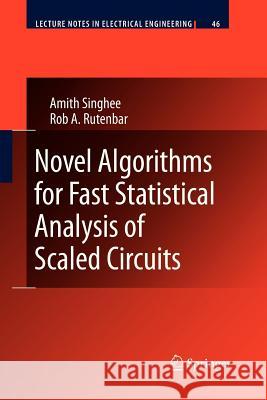Novel Algorithms for Fast Statistical Analysis of Scaled Circuits » książka
Novel Algorithms for Fast Statistical Analysis of Scaled Circuits
ISBN-13: 9789400736870 / Angielski / Miękka / 2012 / 195 str.
Novel Algorithms for Fast Statistical Analysis of Scaled Circuits
ISBN-13: 9789400736870 / Angielski / Miękka / 2012 / 195 str.
(netto: 383,36 VAT: 5%)
Najniższa cena z 30 dni: 385,52
ok. 22 dni roboczych.
Darmowa dostawa!
As VLSI technology moves to the nanometer scale for transistor feature sizes, the impact of manufacturing imperfections result in large variations in the circuit performance. Traditional CAD tools are not well-equipped to handle this scenario, since they do not model this statistical nature of the circuit parameters and performances, or if they do, the existing techniques tend to be over-simplified or intractably slow. Novel Algorithms for Fast Statistical Analysis of Scaled Circuits draws upon ideas for attacking parallel problems in other technical fields, such as computational finance, machine learning and actuarial risk, and synthesizes them with innovative attacks for the problem domain of integrated circuits. The result is a set of novel solutions to problems of efficient statistical analysis of circuits in the nanometer regime.
As VLSI technology moves to the nanometer scale for transistor feature sizes, the impact of manufacturing imperfections result in large variations in the circuit performance. Traditional CAD tools are not well-equipped to handle this scenario, since they do not model this statistical nature of the circuit parameters and performances, or if they do, the existing techniques tend to be over-simplified or intractably slow. Novel Algorithms for Fast Statistical Analysis of Scaled Circuits draws upon ideas for attacking parallel problems in other technical fields, such as computational finance, machine learning and actuarial risk, and synthesizes them with innovative attacks for the problem domain of integrated circuits. The result is a set of novel solutions to problems of efficient statistical analysis of circuits in the nanometer regime. In particular, Novel Algorithms for Fast Statistical Analysis of Scaled Circuits makes three contributions: §1) SiLVR, a nonlinear response surface modeling and performance-driven dimensionality reduction strategy, that automatically captures the designer s insight into the circuit behavior, by extracting quantitative measures of relative global sensitivities and nonlinear correlation. §2) Fast Monte Carlo simulation of circuits using quasi-Monte Carlo, showing speedups of 2× to 50× over standard Monte Carlo. §3) Statistical blockade, an efficient method for sampling rare events and estimating their probability distribution using limit results from extreme value theory, applied to high replication circuits like SRAM cells.











